Physical Address
304 North Cardinal St.
Dorchester Center, MA 02124
Physical Address
304 North Cardinal St.
Dorchester Center, MA 02124
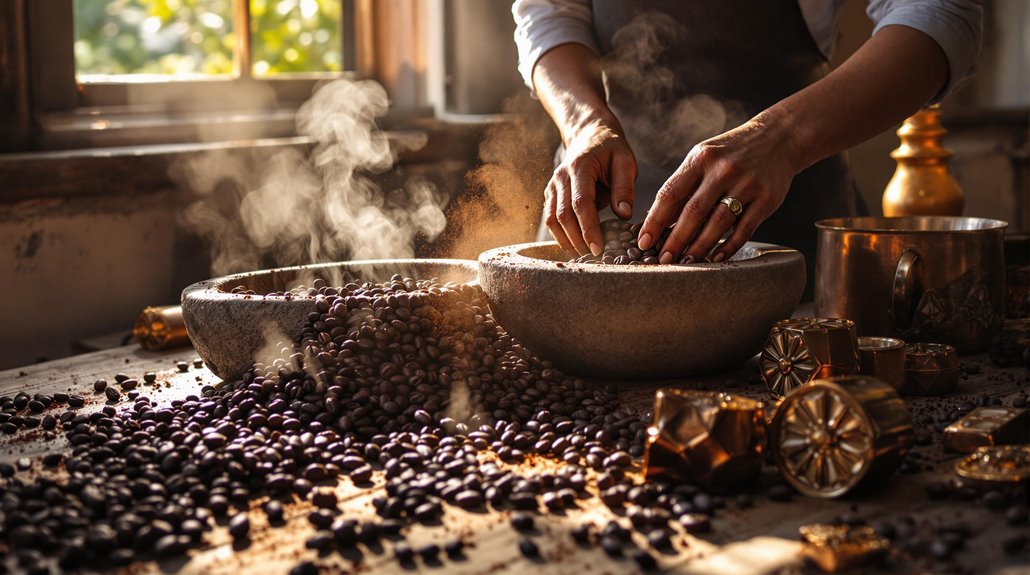
Behind Lima's ChocoMuseo doors, ancient chocolate-making secrets unfold as you transform raw cacao beans into decadent handmade treats.
You'll discover more than just chocolate-making when you step into Lima's ChocoMuseo workshop. As you trace the journey from raw cacao to finished bar, you're connecting with a 4,000-year-old tradition that's deeply woven into Peru's cultural fabric. While the art of chocolate crafting may seem mysterious at first, this hands-on experience will transform you from curious observer to confident chocolatier. What begins as a simple bean holds secrets that only true artisans understand.
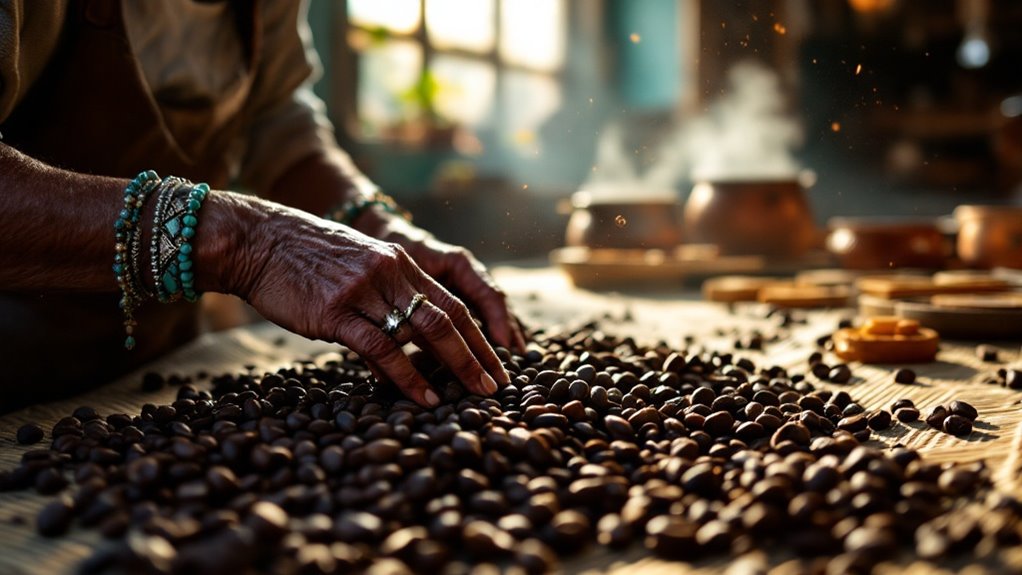
While many today enjoy chocolate as a sweet confection, its origins trace back over 4,000 years to the Olmec civilization of Mesoamerica. The Olmecs first cultivated cacao, using fermented beans to create bitter drinks. The early civilizations prepared it as a hot bitter drink mixed with vanilla, spices, honey, and chili peppers.
Ancient civilizations pioneered chocolate not as candy, but as a bitter drink made from fermented cacao beans.
Later, the Mayans developed "xocolatl," a spiced beverage they used in rituals, while the Aztecs valued cacao beans so highly they used them as currency.
You might be surprised to learn that chocolate didn't become sweet until after the Spanish conquest in 1528. When Hernán Cortés introduced cacao to Europe, the Europeans transformed the bitter drink by adding sugar, cinnamon, and vanilla.
For centuries, chocolate remained a luxury for aristocrats, until the Industrial Revolution. Van Houten's cocoa press invention in 1828 and the creation of the first solid chocolate bar in 1847 revolutionized chocolate consumption forever.
Four distinct regions form Peru's cacao heartland, with San Martín leading national production at nearly 65,000 metric tons annually.
If you're exploring Peru's cacao country, you'll come across Junín ranks second, contributing 33,540 metric tons to the nation's total output of 166,740 metric tons.
You'll discover more than 100,000 families cultivating cacao across these regions, many working in agroforestry systems that protect biodiversity.
The process starts with hand-picking ripe pods and field processing the beans, followed by 1-2 weeks of fermentation and sun-drying.
Most farmers grow CCN51, a disease-resistant variety, alongside Criollo and hybrid varieties.
What's remarkable is that 25,000 acres have switched from coca to cacao in the past decade, making Peru the world's second-largest organic cocoa exporter. Getting access to these production statistics requires a Statista subscription account.
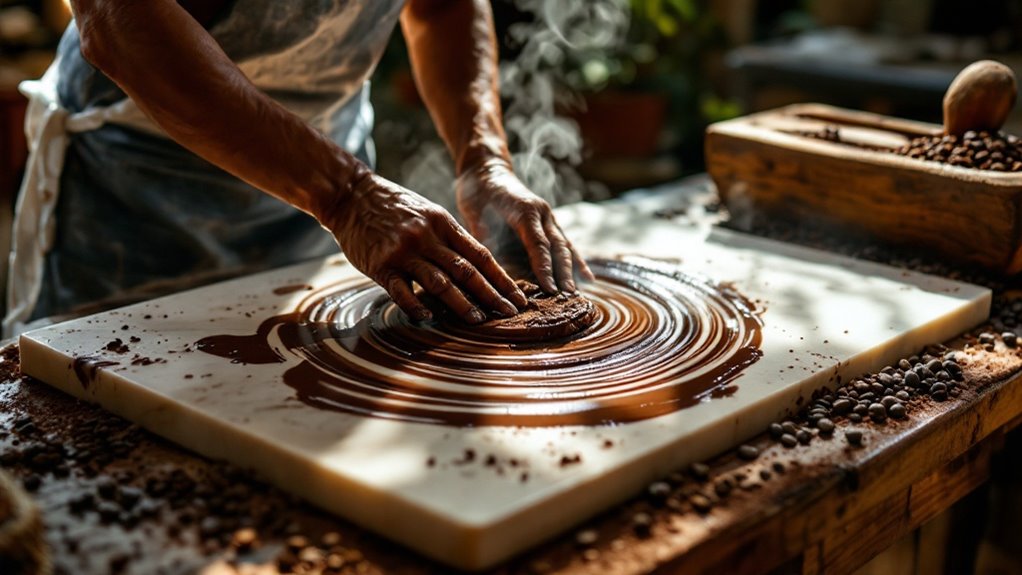
Moving from the farms to Lima's lively chocolate scene, you'll discover an engaging hands-on experience at the city's premier chocolate-making workshops.
During the two-hour session, you'll learn every step of crafting artisanal chocolate, from roasting cacao beans to tempering the final product.
In groups of ten or fewer, you'll use traditional methods and modern equipment like the melangeur to transform raw beans into smooth chocolate paste. The hands-on activities have earned 4.8 out of 5 from hundreds of satisfied participants.
You'll also explore the rich history of Peruvian cacao while tasting the difference between raw nibs and finished bars.
Located conveniently in Miraflores' Inka Plaza, these highly-rated workshops offer three daily time slots and include 130g of your handmade chocolates to take home.
Remember to allow 45 minutes after class for your creations to properly set.
Beyond the hands-on fun of chocolate making lies fascinating scientific processes that transform bitter cacao beans into smooth, delectable chocolate.
You'll discover it's all about precise temperature control, chemical reactions, and particle physics working together to create the perfect bar.
During your chocolate-making journey, you'll encounter these key scientific processes:
These processes aren't just steps – they're the science that makes your chocolate extraordinary.
The conching process, pioneered by Rodolphe Lindt in 1879, revolutionized chocolate manufacturing by transforming gritty chocolate into the smooth, melt-in-your-mouth texture we know today.
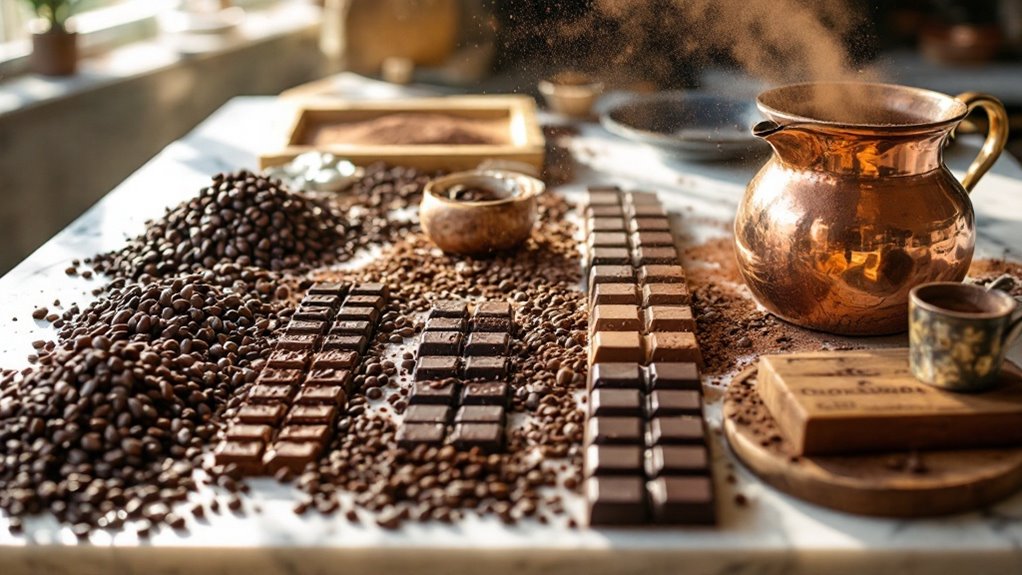
After mastering the science of chocolate making, the fun begins as you create your own custom chocolate bars from scratch.
You'll start by selecting your preferred chocolate base – dark, milk, or white compound chocolate simplifies the process since it doesn't require tempering. Proper chocolate consistency can be tested by dipping a spoon and ensuring smooth coverage.
Using food-grade silicone molds, you can create intricate designs that hold 80-100 grams per cavity.
You'll fill the molds using parchment paper cones for precision, then tap them gently to remove air bubbles.
Add your chosen inclusions like crushed Oreos or freeze-dried raspberries, and enhance flavors with essences at 0.25-0.5 teaspoons per batch.
For finishing touches, consider sea salt flakes or edible gold dust.
Let your bars set at room temperature for 2-4 hours or refrigerate for 20-30 minutes before carefully demolding your creation.
While creating delicious chocolate is essential, sustainable bean-to-bar production guarantees a positive impact on both people and planet.
When you choose sustainably-sourced cacao, you're supporting practices that protect biodiversity and guarantee fair compensation for farmers.
Key sustainable practices you'll want to implement:
These methods not only preserve the environment but also result in higher quality chocolate while supporting farming communities through fair wages and improved working conditions.
Since cocoa trees require approximately five years to mature, planning ahead and patient cultivation are essential aspects of sustainable production.
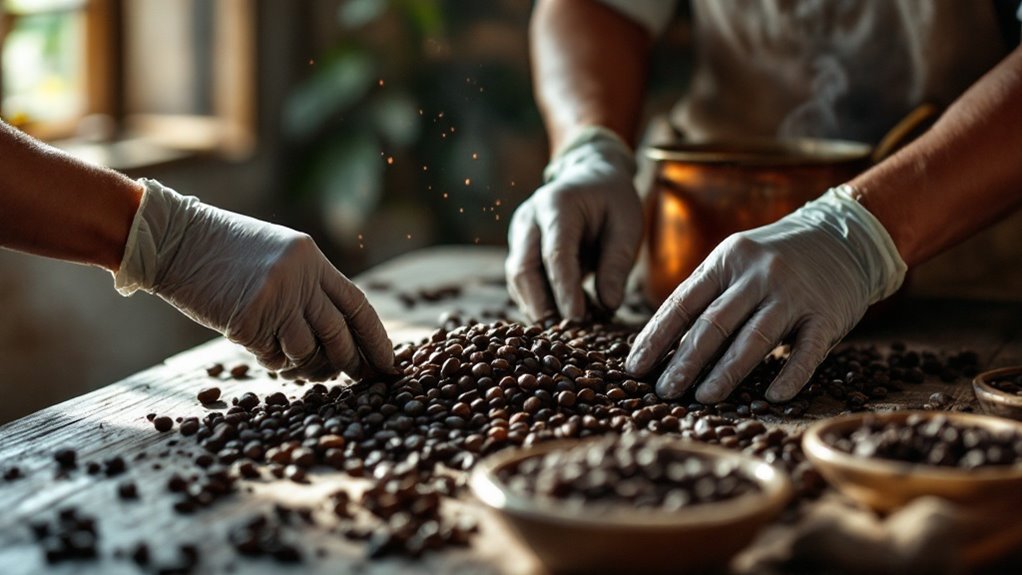
From ancient Incan traditions to modern artisanal innovation, Peru's chocolate legacy comes alive through its diverse array of drinks and treats.
Peru's rich chocolate heritage bridges millennia, blending ancestral wisdom with contemporary craftsmanship in every delectable creation.
You'll discover traditional hot chocolate made with dark chocolate (85%+ cocoa) and spices like cinnamon and cloves, often thickened with cornstarch and sweetened with condensed milk. This comforting drink offers warmth and energy during Peru's cooler periods.
During the summer Christmas season, Peruvians gather to share this rich beverage with panettone, maintaining a cherished holiday tradition.
Today's artisanal makers like Cacaosuyo and Q'uma craft award-winning bars that showcase distinct regional flavors – from Piura's fruity notes to Cusco's herbal undertones.
Experience this legacy firsthand at ChocoMuseo Lima, where you can join bean-to-bar workshops to create your own chocolates while learning about Peru's 3,000-year relationship with cacao.
You'll leave Lima's ChocoMuseo with more than just handmade chocolate bars. You've gained insights into Peru's rich cacao heritage, mastered basic chocolate-making techniques, and understood the importance of sustainable practices. Whether you're planning to continue crafting chocolate at home or simply want to appreciate fine chocolate better, this hands-on workshop connects you directly to Peru's ancient chocolate-making tradition.